Cape Verdean labourers, settlers and emigrants
Angola, faraway land
They arrived in Angola 100 years ago. They witnessed the decline of a colonial power that instrumentalized them and the birth of the Angolan nation. The memory of Cape-Verdean immigrants in our country tells a story of oppression and resistance that the creole sociologist Nardi Sousa salvaged and is to publish in a book.
Cape Verde and Angola share a common history, episodes of an empire built on maritime expeditions and overthrown by anti-colonial shoulder-to-shoulder struggles. But there is another bond, an emotional one, that connects the two countries for exactly 101 years when, in 1914, the first registered immigrants from the islands set foot on Angolan soil. There were little more than 90 of them.
Creoles in southern Africa, their journey salvaged by the Cape Verdean sociologist Nardi Sousa and to be published in the book Contratados e Povoadores Cabo-verdianos em Angola: Serviçais, Segundos Europeus ou Imigrantes (1947-1973) [Cape Verdean Labourers and Settlers in Angola: Servants, Second-class Europeans or Immigrants (1947-1973)]. “I believe that Angola is the country in the world where Cape Verdeans have felt most at home away from home”, he says in an interview with the magazine Austral. This is even more true if we consider the amplitude and diversity of the epic creole “world” – there are more Cape Verdeans today in countries like Portugal, Holland and the United States than on the ten islands known for morabeza, or the art of hospitality.
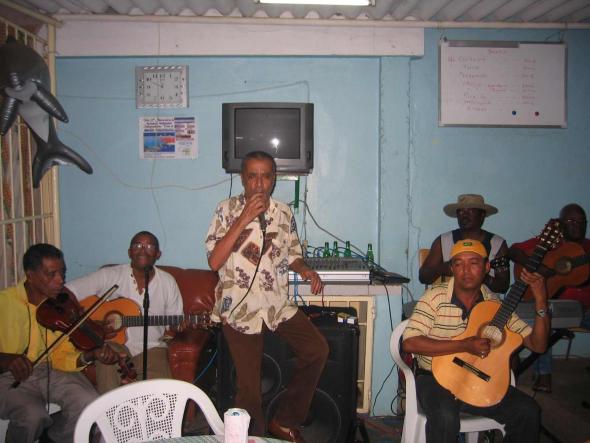
Living in Luanda from 2003 to 2009, Nardi conducted fieldwork and experienced personally what he describes as “the robust integration of Cape Verdeans in Angolan society”. “There are many mixed marriages. One only needs go to Prenda, São Paulo, Sambizanga, Boavista, neighbourhoods where the majority of Cape Verdeans of Luanda and their descendants live, and observe the way they interact with the Angolans”, explains Nardi, who is currently a professor at the University of Santiago, in Cape Verde.
“Ramadiado dja caba na Angola” [Those who were average left for Angola]
In a musical country as Cape Verde, the legendary Codê di Dona enacted, with his sharp popular wisdom, the historical relations of the islands with Angola. In the classic “Febri di Funaná” [Fever of Funaná], the musician bridges various historical Cape Verdean emigration destinations.
Codê sings:
“Qui tem dinheiro dja cá ba Holanda
Qui s’tai na djeto dja cá bá Lisboa
Ma ramediados dja cá bá Angola
Dizanimadus dja cá santa Praça”.
The journalist José Vicente Lopes provides the Portuguese translation from the city of Praia:
Quem tem dinheiro já embarcou para a Holanda
Quem tem algum já embarcou para Lisboa
Os remediados já embarcaram para Angola
Os desanimados assentaram praça (= foram para a tropa)
Accordingly, in English:
Those who were rich left for Holland
Those who were comfortable left for Lisbon
Those who were average left for Angola
Those who were disheartened joined the military
Emigration became a question of life and death for many Cape Verdeans, regardless of their material and economic means. In the 1940s, the archipelago was hit by a particularly devastating cycle of droughts and famines that caused the loss of almost half of the existing colonial population. Famintos [The Famished] is Luís Romano’s brutal humanization of the bleak statistics: “It was the reins of total dead silence: estates, villages, houses here and there that remind of the names of those who left or were buried anyhow and those insistently unearthed by large birds”.
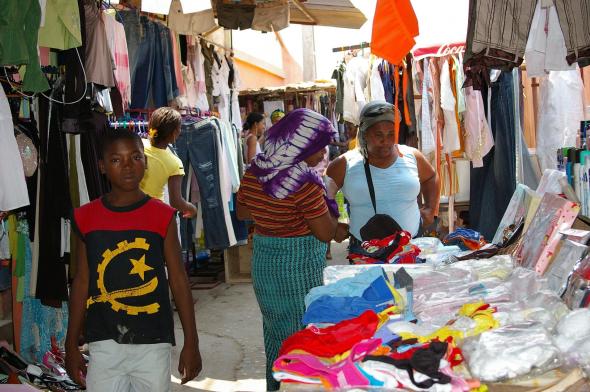
Starved, many Cape Verdeans embarked on what was the first big wave of forced emigration to Angola. “The regime needed to alleviate the demographic pressure in Cape Verde. The population density, 319 inhabitants per square kilometre, made resource management difficult in times of crisis and drought”, comments Nardi Sousa. “For the regime, Cape Verdeans were among the most educated people of the ‘Portuguese empire’. They were considered ‘civilized’, ‘not indigenous’ e perfect intermediaries between the Africans and the Europeans. Basically, the colonial authorities used the creole workforce to fulfil their interests in Angola”.
For this, a “brain-washing” strategy was applied. The labourers were promised good living standards, attractive salaries, which was enormously deceptive”, says the author. Arriving in Angola, they were transferred to the lands of the Agricultural Company of Angola in Catumbela and in Cuanza Sul. Others went to Lundas, to work for Diamang, a colonial diamond company, and, to a lesser extent, to the coffee and cotton plantations of Uíge. Some, “very few”, managed to escape and settle in Luanda. “The city was an important commercial centre. It attracted Cape Verdeans, who were not prepared for farm work at all,” he explains.
Creole settlement
The labourers belonged to a period that lasted until the early 1960s. After 4 February, the Portuguese authorities reformulated their colonial policy, giving the Cape Verdean emigrants a new status: “colonos” or “povoadores”, meaning those who settle and inhabit. In 1962, continues Nardi Sousa, “the first 197 Cape Verdean settlers arrived. They were from the islands of Fogo and Brava.” Then, 25 creole colonatos [settlements] were created, spreading across the provinces of Bié, Moxico, Uíge, Cuanza Norte and in Mabuia, province of Bengo.
In a repressive society, the “settlers-to-be” needed to obtain the approval of the governor of Cape Verde and that of the Junta de Povoamento [Settlement Board] to emigrate. During the voyage, “they were informed by Portuguese authorities about the best way to obtain lands and to be on good terms with neighbours. They were told how to behave, now that they were no longer labourers, but settlers. This implied accepting imperial unity”, according to the research of Nardi Sousa. As part of this colonialist logic, “between 1961 and 1963, some Cape Verdeans joined the Provincial Organization of Volunteers and of Civil Defence of Angola, committing many abuses against the Angolans”, suggests the scholar, referring to a dark period of relations between these two peoples, marked by constant “rapprochements and frictions”.
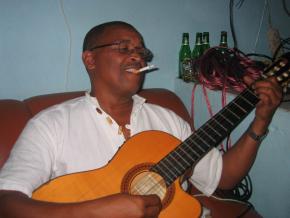 This is also when Cape Verdeans arrived in Luanda to work as colonial civil servants. Among these, Silva Tavares made it to the position of High Commissioner and General Governor of Angola. “Portugal thought that, with the massive presence of foreigners, Angola would never be independent”, concludes the sociologist from Tarrafal of Santiago. The strategy did not work and, in 1968, the Junta de Povoamento abandoned the creole colonization of Angola.
This is also when Cape Verdeans arrived in Luanda to work as colonial civil servants. Among these, Silva Tavares made it to the position of High Commissioner and General Governor of Angola. “Portugal thought that, with the massive presence of foreigners, Angola would never be independent”, concludes the sociologist from Tarrafal of Santiago. The strategy did not work and, in 1968, the Junta de Povoamento abandoned the creole colonization of Angola.
Crossed Independences
Almost 30 year of creole emigration to Angola left its mark, object of historical studies. Nardi Sousa is not argumentative but firm: “Cape Verdeans were instrumentalized by Portugal, creating the perception that they were the colonial authorities’ right hand”.
However, “the Cape Verdeans had conflicts not only with the Angolans, but also with the Portuguese authorities. They even beat the colonial guards in defence of their dignity”, he says. “Cape Verdeans rejected bad fish, bad fuba [cassava flour], eating with spoon, whipping, cutting off the hair of women as punishment, roping the feet of Angolan labourers. Many Cape Verdeans challenged the regime and took the side of the Angolans”. “N ca ta nhó”, they answered the indigenous police, an unyielding negative expression in Cape Verdean creole, something like “I will not do this, sir!”. Uttered many times over, Angolans came to know them by “catanhós”, which is still quite common today.
Meanwhile, the consciousness of having been used by the regime as pawns was increasingly widespread among the Cape Verdeans in Angola, especially since 1966. And what caused the alert? “The spread of fellow Angolans’ struggle for independence”, says Nardi Sousa. From that moment, “many creoles began to support the MPLA, whose ideals and objectives were very similar to theirs. A considerable number of them eventually enlisted in the Angolan liberation movement.”
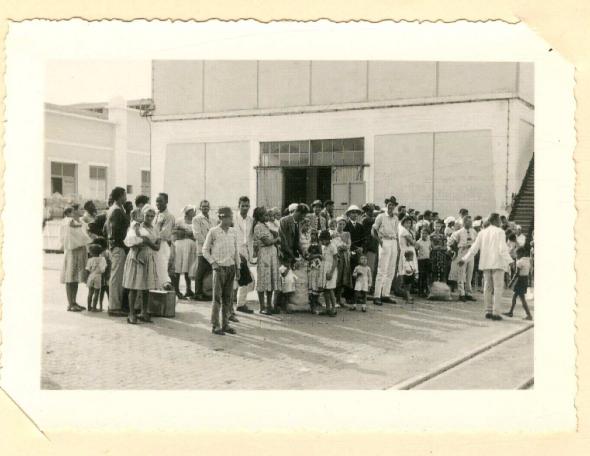
With history in acceleration, the popularity of the Cape Verdean Amílcar Cabral in Angola, the legendary leader of the African Party for the Independence of Guinea and Cape Verde (PAIGC), contributed to the awakening. “He visited Angola several times as agronomist and seized the chance to make communities aware of the cause for independence of Cape Verde and Angola”, explains Nardi Sousa.
After consecutive struggles, on 5 July 1975, Cape Verde finally declared independence. By that time, Angola realized that they were burdened with an uncertain future. Following South African invasion of Angolan territory, the newly established creole government, led by Aristides Pereira, reached out to Agostinho Neto. In a report on the relations between the two countries published in the Cape Verdean newspaper A Semana in 2005, Aristides Pereira recalls: “At the time, Cape Verde created an air corridor that permitted the Cuban forces to travel from the island of Sal to Luanda. It was a risk that we took, against all western positions, but we had no option, we acted in the name of solidarity with Angola”. Two countries brothers in arms ever since.
Camouflaged Citizenship
Politics apart, Angolan independence marked a turning point in the history of Cape Verdeans in the country. According to the estimate of the creole historian António Carreira, “between 1974 and 1975, approximately 7000 Cape Verdeans wanted to return to Cape Verde”, cites Nardi Sousa. “They were integrated in the Portuguese administrative culture and so there was great uncertainty about the future”, he explains. “At the time, a newspaper stated that there were roughly 40,000 creole employed in Angola in the colonialist economy. Carreira indicates 20,000.” Despite this, “most stayed”, he remarks.
In the following years, many became Angolans through naturalization, living with some sort of “camouflaged citizenship”. “We have people in the community that are quite influential at the higher political levels, specialists in different areas. During the civil war, they tried not to reveal their origin in order to avoid stigmas”, he says.
However, it is difficult to forget one’s roots and “we are witnessing a cultural reawakening”, as the sociologist’s field observation reveals. This is driven by the intense cultural conviviality between the two countries, especially through music. There are the celebratory examples of Paulo Flores and Tito Paris; Bonga and Cesária Évora in “Sodadi”; Ciz herself in the eternal refrain “Angola, Angola, oi qu’povo sabe” [Angola, Angola, what a wonderful people]. Music of Ramiro Mendes, of the Mendes Brothers, also authors of the famous “De Cabinda ao Cuene” [From Cabinda to Cuene], adapted by Angolan musicians like Nanuto. This is not to forget the creole Mayra Andrade, who lived in Luanda as a child, the Angolan Duarte, resident on the island of São Vicente, among many others.
In the Angolan capital, the neighbourhood of Prenda also preserves this foundational creole spirit. It was there that Cape Verdeans labourers from São Tomé settled and that iconic places like the old Salão Biúca, previously party locations of Bana and Luís de Morais, two music giants of the islands, emerged. The market of Prenda continues also to be a place full of descendants of the first insular emigrants, where variants of the creole tongue from several islands can still be heard.
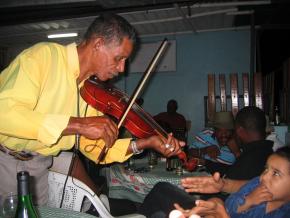 And how can we miss the place of Ti Jorge, in Chicala, where night after night Angolans and Cape Verdeans came together? Shut down some years ago, Cape Verdean music at Ti Jorge used to be mainly interpreted by the imperial voice of Pedro Rodriguez, the great “Maiuca”, now gone. Such are the memorable symbols of the fusion of two countries.
And how can we miss the place of Ti Jorge, in Chicala, where night after night Angolans and Cape Verdeans came together? Shut down some years ago, Cape Verdean music at Ti Jorge used to be mainly interpreted by the imperial voice of Pedro Rodriguez, the great “Maiuca”, now gone. Such are the memorable symbols of the fusion of two countries.
Cuca, beans and Morabeza
The relations between Angola and Cape Verde are strong and characterized by solidarity. In Cape Verde, Cuca beer was famous in the 1970s. It was imported from Angola, like cassava flour. The so-called “farinha de pau” was mixed with sugar or went with tuna and mackerel.
Corn and beans made their way to the islands from Benguela. In an interview with the newspaper A Semana, the ex-president of the now defunct Agência Nacional Alimentar de Cabo Verde [National Food Agency of Cape Verde], António Monteiro, recalls a ridiculous episode: “In 1977, Angola gave us in one go 10,000 tonnes of beans. We did not have the storage capacity and, in order not to let the beans go bad, we were obliged to export the excess quantity”. With the civil war in Angola, it was Cape Verde’s turn to help Luanda, especially with medications from Emprofac and products of the Morabeza manufacturing company.
This “djunta mon” [joining hands; mutual help] never stopped. During the recent volcano eruption on the island of Fogo, Angola sent generous supplies to help rebuild communities destroyed by lava.
Photos: Arquivo Austral, Pedro Cardoso and Germano Liberato
Article originally published in the magazine Austral no. 110.